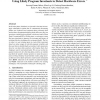Free Online Productivity Tools
i2Speak
i2Symbol
i2OCR
iTex2Img
iWeb2Print
iWeb2Shot
i2Type
iPdf2Split
iPdf2Merge
i2Bopomofo
i2Arabic
i2Style
i2Image
i2PDF
iLatex2Rtf
Sci2ools
DSN
2008
IEEE
2008
IEEE
Using likely program invariants to detect hardware errors
In the near future, hardware is expected to become increasingly vulnerable to faults due to continuously decreasing feature size. Software-level symptoms have previously been used to detect permanent hardware faults. However, they can not detect a small fraction of faults, which may lead to Silent Data Corruptions(SDCs). In this paper, we present a system that uses invariants to improve the coverage and latency of existing detection techniques for permanent faults. The basic idea is to use training inputs to create likely invariants based on value ranges of selected program variables and then use them to identify faults at runtime. Likely invariants, however, can have false positives which makes them challenging to use for permanent faults. We use our on-line diagnosis framework for detecting false positives at runtime and limit the number of false positives to keep the associated overhead minimal. Experimental results using microarchitecture level fault injections in full-system simu...
Related Content
| Added | 29 May 2010 |
| Updated | 29 May 2010 |
| Type | Conference |
| Year | 2008 |
| Where | DSN |
| Authors | Swarup Kumar Sahoo, Man-Lap Li, Pradeep Ramachandran, Sarita V. Adve, Vikram S. Adve, Yuanyuan Zhou |
Comments (0)

